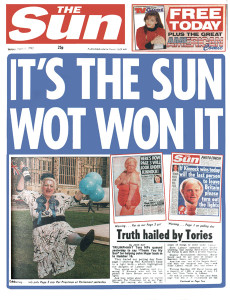 It won’t have escaped anyone’s notice in the UK that there is a General Election about to happen. There has been coverage almost everywhere on all possible media channels.
It won’t have escaped anyone’s notice in the UK that there is a General Election about to happen. There has been coverage almost everywhere on all possible media channels.
But how you have engaged with the election is the thing that may well have changed in 2015.
For years, the daily newspapers have wielded huge clout. The infamous Sun front page in 1992, after Neil Kinnock failed to unseat John Major’s Tory government is a classic example.
Fast forward 5 years and Rupert Murdoch’s endorsement of Tony Blair in 1997 was considered enormously important to the first Labour victory since James Callaghan in the 1970s.
And it’s not hard to see why. Up until the mid-2000s, front pages of national newspapers were seen and read by millions.
This was, of course, before the mass adoption of the internet and, specifically, social media, both of which have contributed strongly towards the huge decline in newspaper circulation.
To give you some idea of the seismic dip, here are the 1997 and 2015 figures for four popular newspapers:
| Newspaper |
1997 |
2015 |
Drop (%) |
| The Sun |
3,877,097 |
1,978,702 |
?49 |
| The Mirror |
2,442,078 |
992,935 |
?59 |
| The Telegraph |
1,129,777 |
494,675 |
?56 |
| The Guardian |
428,010 |
185,042 |
?56 |
The campaign in 2015
Not all ‘old’ media is taking a hit, though. TV is still an extremely important medium for all political parties. Although ‘linear’ watching has declined with the rise of catch-up services, the viewing figures for the ITV Leaders debate shows that people are still switching onto important events.
However, as demonstrated above by dwindling newspaper figures, the sway that newspapers hold is much smaller.
And where newspapers’ influence is shrinking, so their fear of online is becoming clearer and clearer. Case in point this week was the news that Ed Miliband was interviewed by Russell Brand for his YouTube channel The Trews.
The reaction of the right-wing media has been, frankly, hysterical, as shown by tweet below.
And the reason for this is quite simple. To misappropriate a popular ad campaign from the 80s: people like Russell Brand reaches the parts of the electorate that newspapers can’t reach.
Brand’s online demographic is the young, the disaffected, the new generation of voters who couldn’t give a stuff about what The Sun or The Telegraph is saying.
The newspapers fear this. And the only way they can think of to counter this is stir up their own brand of fear (pun not intended).
How the web is unravelling spin
What’s also noticeable during this election is that only the most robust of facts is being allowed to stand.
On 27 April, The Telegraph published a letter signed by 5,000 small businesses saying they support the Tories.
Before the end of the day was out, it was revealed that the letter had been orchestrated by the Conservative party itself, contained duplicate names and not every signee agreed to have their name added.
Once again proof that the power that newspapers once had has been slowly undermined. The media landscape has changed so greatly that they will never achieve that might again.


 It won’t have escaped anyone’s notice in the UK that there is a General Election about to happen. There has been coverage almost everywhere on all possible media channels.
It won’t have escaped anyone’s notice in the UK that there is a General Election about to happen. There has been coverage almost everywhere on all possible media channels.